Fair Ridge Cemetery
Fair Ridge Cemetery was established in 1867 by a group of public-spirited local citizens, who created, in their words, “an association for the purpose of procuring and holding land to be used exclusively for a cemetery or place for the burial of the dead.” It was designed to be non-profit and non-sectarian. The first president was Horace Greeley.
At that time, there were only three cemeteries in New Castle, all of which held religious affiliations – the Quaker graveyard in Chappaqua, and the Episcopal and Methodist cemeteries in Mount Kisco. They were relatively small, and it was apparent that vacancies there would become more rare. Public cemeteries, like Fair Ridge, probably became popular because many local families may have wanted a better alternative to the smaller burying grounds they had formed on their own properties. Finally, families might have preferred to bury their loved ones in a cemetery to keep up with current fashion. The earlier graveyards were not planned, but simply grew. The graves tended to be laid out in rows and oriented so that on the Day of Judgment, the deceased would face the rising sun. During the 19th century, these graveyards were supplemented by “rural” or “garden” cemeteries, laid out like parks. The monuments were given more space, and oriented to be viewed from curving paths and carriageways.
Fair Ridge Cemetery is a compromise between the old and new. It is made up of individual family plots, some laid out in rows, some not. Some contain a single large family monument, accompanied by smaller individual markers. The cemetery came into use as soon as it was founded, and some earlier graves were evidently moved here from someplace else.
Haviland Family Plot
On this tour, we can visit only a sample of the many interesting graves here. We’ll start with what we call Founders’ Circle, in honor of the founders of the cemetery who have plots here.
Haviland was a very solid citizen in every sense of the word. He was a Quaker, and particularly involved in the Chappaqua Mountain Institute, the Quaker school founded in 1870. The school property is now Wagon Road Camp, right across the street.
He was a friend of Horace Greeley’s, and sold Greeley much of his farm. He may have recruited Greeley to be the first president of the cemetery association. His home on South Bedford Road is now a New Castle landmark.
If you didn’t already know that Rebecca and Robert Haviland were devout Quakers, the dates on their monument would tell you so. Traditional Quakers disliked using the pagan names of the months and weeks. Thus, January became “First Month,” Sunday became “First Day,” and so forth. Rebecca’s birth date reads, “1st Month, 19th [Day], 1849,” and her death date, “3rd Month, 30th [Day], 1929.”



Underhill Family Plot
Next to the Havilands are the Underhills. Jesse Underhill sold the original 12 acres of the cemetery to the Fair Ridge Association, and then became its treasurer. After buying this plot, he moved the graves of his parents and other relatives here.
His descendants erected a large granite monument for him and his wife at the center.
The Underhills lived nearby on Quaker Road. Here is how the house used to look. Unfortunately, it has been so greatly altered that it barely resembles the original.
The Underhill family in America goes back to John Underhill, a professional soldier in the 1600s. He is most notable for slaughtering an entire Indian village in Bedford — 400 men, women and children – in the 1640s. He later settled on Long Island, became a Quaker, and married a Quaker woman. Presumably he repented, and accepted the Quaker Peace Testimony. Most of the Underhills in New Castle were Quakers.



Wanzer Family Plot
The Wanzer family can also be traced back to the 1600s, when its founding members immigratedfrom Holland to New Amsterdam. Moses Wanzer was one of the first so-called “hilltoppers” in New Castle. The hilltoppers were mostly prosperous New York businessmen, who bought up old farms to form large estates, and then built big homes on high ground, where they could readily see and be seen.
Moses Wanzer’s estate was on the east side of Bedford Road, north of the King Street intersection. His original house was next to the road, but in the 1880s he built a new home in the fashionable French Second Empire style on a plateau set much further back. In the early 1900s, the Wanzer estate was acquired by John Isaac Devoe Bristol and his son-in-law, Albert Turner, who owned and developed many properties in New Castle. They laid out Brevoort Road through the estate, and they retained the Wanzer house. With additions, it still exists.
Bristol and Turner renamed it “Tribune Cottage,” in honor of Horace Greeley’s newspaper. Unfortunately, that’s how myths get started. According to this myth, Horace Greeley not only owned the house, but even kept a mistress here. Of course, it was built some 15 years after Greeley’s death, but, as we know, facts have never killed off a good story.



Haight Family Plot
The Haights were among the pioneer families in New Castle. Three branches – two Quaker and one Episcopalian — settled here in the 1700s. One of the Quaker branches owned extensive property on both sides of Bedford Road, north of the King Street intersection. (The Wanzer estate was later carved out of part of it.) The earliest Haight homestead was right at the corner, where Walgreen’s is now.
The house was built by Aaron Haight, and replaced an even earlier one that burned. When Aaron and his son Israel lived there, their farm was largely devoted to apple orchards.
That’s where the name Orchard Ridge comes from. About the turn of the 20th century, the property was divided up and sold. One son, George Washington Haight (see monument), was a tenant in the Greeley House about 1900.



Daniel and Anna Hallock Gravestones
Daniel Hallock was a farmer. During the last half of the 1800s, he lived in a house on Seven Bridges Road. It is located just across the street from the end of McKesson Hill Road. Before Seven Bridges Road was laid out, McKesson Hill Road was simply the driveway to the farm, connecting it to Quaker Road.
The house was in existence long before the Hallocks moved there. It was originally built in the 1700s by Stephen Carpenter, and then much enlarged and altered. The interior is quite complex, and contains seven different levels. At the lowest level is what is probably the original kitchen hearth, with an accompanying beehive bake oven. The house and much of the farm remained in the possession of the Hallock family well into the 1900s.


John Y. Haight Family Gravestones
We now pass from Section 1 to Section 2. It extends along both sides of the main drive. Sections 1 and 2 constituted the whole cemetery until the late 1800s. They still contained empty plots after later sections were laid out, so they both contain graves of the 20th century, as well as earlier ones.
We have mentioned the three branches of the Haight family. The second Quaker branch owned extensive property along Whippoorwill Road. Haights Cross Road was the connection between King Street and the original homestead on Whippoorwill. It’s the site that older residents remember as Sutton Farm. The founding father was Caleb Haight.
Over the years, parts of the Haight property were given or bequeathed to Caleb’s descendants. Some time before his death in 1819, he gave the land at the intersection of Whippoorwill and Haights Cross Roads to his son Samuel. Samuel in turn left it to his son, John Y. Haight.
Here is how Samuel and John Y. Haight’s house looks today. The story-and-a-half house with eyebrow windows, at the left, is typical of the small homes of the late 1700s. It may already have existed when Samuel Haight acquired the property. The larger, center-hall house was completed before Samuel died in 1838.
This house has changed little since the 1800s. In fact, it is virtually the same as it was when it was still a farmhouse in the 1890s.



Gravestones of Josiah Quinby Descendants
The Quinbys were Quaker pioneers, who had a big farm on Whippoorwill Road, straddling the boundary between New Castle and North Castle. In the late 1700s, Josiah Quinby established his own big farm on Millwood Road, east of Seven Bridges Road.
At least three generations of Quinbys made their homes on parts of it. This house, at the corner of Millwood and Seven Bridges, is the most conspicuous of those that survive.
Buried in this family plot are some of Josiah Quinby’s descendants (see monuments). Notice the small stone. It is one of all too many you’ll find in old graveyards. It marks the graves of Ida and Cora, “Our Little Lambs” – two sisters who died the same day, probably in one of the epidemics that could quickly wipe out whole families of children.
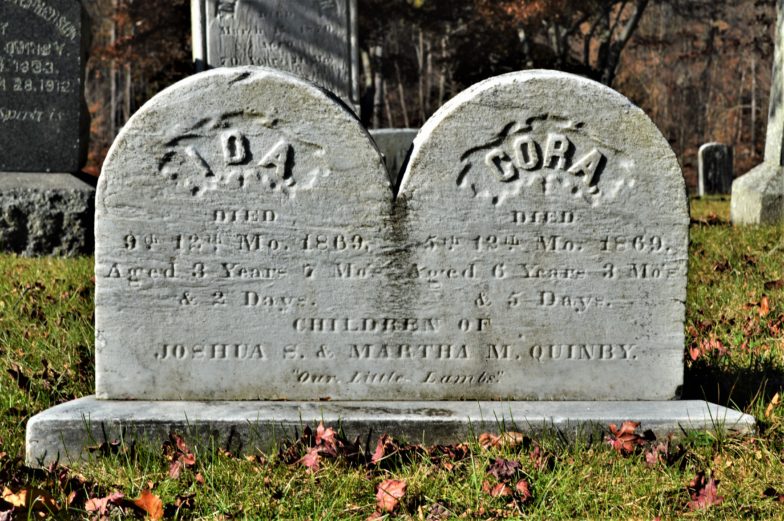
Morgan Washburn Family Gravestones
One of the largest and most widespread families in old New Castle was made up of the descendants of Richard Washburn. Morgan Washburn and his wife Debro lived on Barnes Road out in the far West End of town.
His home, with its eyebrow windows on the second floor, is typical of Federal-style houses of the early 1800s. We don’t know precisely when he acquired it, or whether he was the one who built it. We only know that he was living there in 1846, when he sold a corner of his property to his next-door neighbor. In any event, it still exists much as it originally was.
Like most of the Washburns, Morgan Washburn and his wife were Quakers, and their gravestones are dated in the Quaker style. Hers is clearer: “5th month 14th [Day] 1886.”



Wanzer Family Plot
The Wanzer family can also be traced back to the 1600s, when its founding members immigratedfrom Holland to New Amsterdam. Moses Wanzer was one of the first so-called “hilltoppers” in New Castle. The hilltoppers were mostly prosperous New York businessmen, who bought up old farms to form large estates, and then built big homes on high ground, where they could readily see and be seen.
Moses Wanzer’s estate was on the east side of Bedford Road, north of the King Street intersection. His original house was next to the road, but in the 1880s he built a new home in the fashionable French Second Empire style on a plateau set much further back. In the early 1900s, the Wanzer estate was acquired by John Isaac Devoe Bristol and his son-in-law, Albert Turner, who owned and developed many properties in New Castle. They laid out Brevoort Road through the estate, and they retained the Wanzer house. With additions, it still exists.
Bristol and Turner renamed it “Tribune Cottage,” in honor of Horace Greeley’s newspaper. Unfortunately, that’s how myths get started. According to this myth, Horace Greeley not only owned the house, but even kept a mistress here. Of course, it was built some 15 years after Greeley’s death, but, as we know, facts have never killed off a good story.



Hunt Family Plot
These granite markers are those of the Hunt family of early Chappaqua merchants.
Until the coming of the railroad in 1846, there really wasn’t a downtown Chappaqua. The original hamlet was concentrated around the Quaker meetinghouse. Most of it was residential. But as soon as the railroad arrived, the area around the station became a commercial boom town. The general store of Levi Hunt was located just west of the railroad crossing. It was one of the most important in town, and served as a kind of community center. Horace Greeley used to drop by to visit with his neighbors.
During the late 1800s Levi Hunt helped his son George establish a coal and feed business across the street, in a building that was originally the railroad freight station (see early photograph). After the bridge was built over the railroad and the street-level crossing was closed, the old general store was demolished. The fuel business survived for a couple of decades longer, and the building then became the home of the Chappaqua Drama Group. The site is now being developed for affordable apartments.

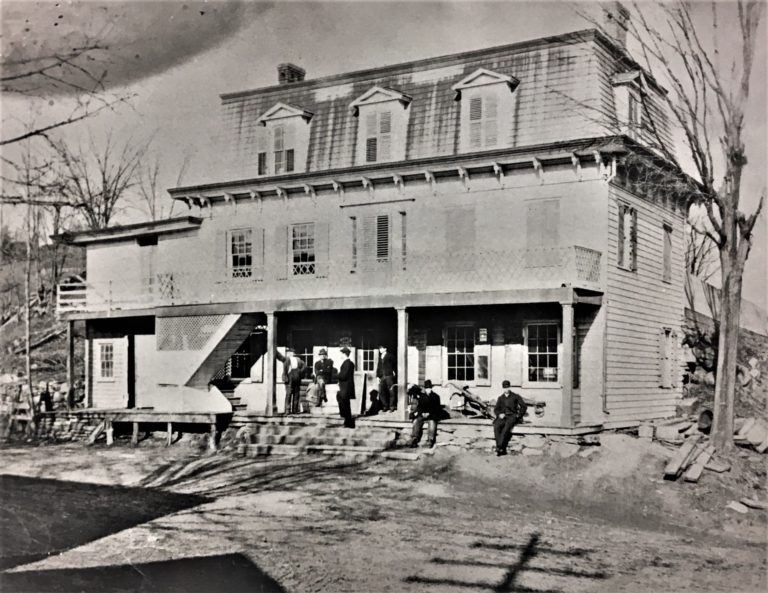

Charles B. Griffith Monument
In the 18th and 19th centuries, there were sawmills and gristmills in the area of Quaker Road near Kipp Street. One of the mill ponds still remains – we call it the Duck Pond.
In the later 1800s, the mill here was owned by Charles B. Griffith. He was married to a Kipp family daughter, and they lived on Kipp Street. Across the way was a large lake — now just an extensive wetland. It served as a reservoir for the mills downstream.
About 1890, Griffith celebrated his success by building a much larger picturesque French Second Empire house next door to his former home. It is now a New Castle Landmark.



Tompkins Family Plot
Amos Tompkins was another Chappaqua merchant on lower King Street. His grain and feed store was known as Feedbag Hall. It was located near the northwest corner of North Greeley Avenue. In Horace Greeley’s time, it also housed the Chappaqua post office.
The Tompkins family lived in a house next door. Feedbag Hall was demolished long ago, but the house has survived. In the 20th century, Amos’s granddaughter, Amelia Tompkins Caiani, turned the first floor into the Florentine Gift Shop. The former front porch has since been enclosed to include display windows, and it is now the Scattered Books store.
At the back of the family plot is a single monument for Amelia Caiani; her mother, Emma Tyler Tompkins; and four of her siblings who died young. Three of them died in 1918 – probably the victims of the great flu epidemic that year.






Outhouse Family Plot
One of the oldest houses in New Castle is this landmark on Roaring Brook Road. Roaring Brook was a major highway before the age of the automobile, and this house was originally a wayside inn and tavern. Several town meetings were held there in the early 1800s.
In the mid-1899s, it was the home of James and Catharine Outhouse. They had three sons, William, Warren, and George. They were Quakers, but decided to ignore the Quaker Peace Testimony, and joined the army during the Civil War. None of them are buried here. William died in a railroad accident in Illinois, and was buried there. George was wounded, but survived, and became a citizen of Yorktown. Warren came through unscathed, returned to Chappaqua, and is buried in the Quaker graveyard down the street. The Quakers are quite forgiving.
Later generations of the Outhouse family lived here until well into the 1900s. This photograph shows family members on the front porch in the 1890s (see early photograph).



Isaiah T. Williams Gravestone
Isaiah T. Williams was a notable lawyer in New York City. His principal client was Horace Greeley. Greeley’s frank and fearless editorials in the Tribune made him the target of numerous lawsuits for libel.
In the 1860s, Greeley may have inspired Williams to establish his own country home in Chappaqua. He purchased an existing estate on Quaker Road, north of Kipp Street. It contained a substantial house in the Italianate style, constructed about a decade before.
The house was in fact enlarged from a much earlier one. The original small cottage had been the home of pioneer John Reynolds, and the property extended all the way up Quaker Road to the meetinghouse. The remnant that Williams bought still contained many acres. It remained in the family into the 20th century, when it was gradually sold off for suburban subdivisions. The house is now a New Castle Landmark.
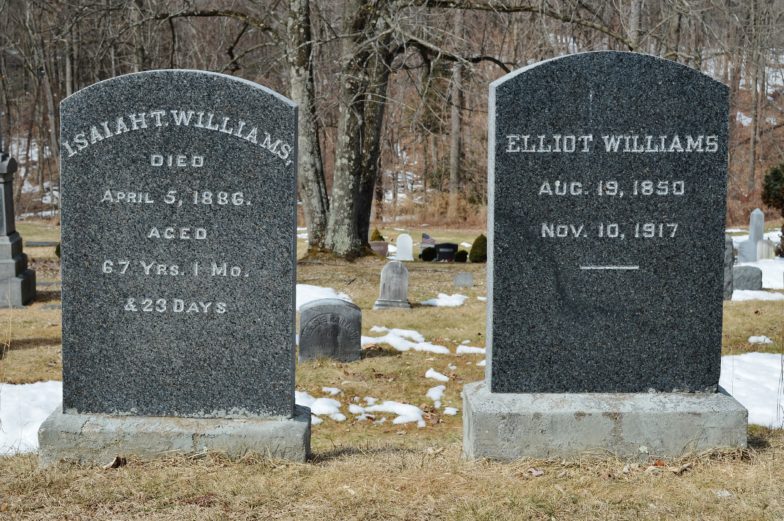


Washburn Family Plot
As we’ve said, among the largest families in New Castle were the Washburns. The family had several branches. The most prominent lived on a large farm along South Bedford Road.
In the late 1800s, the owner was Joshua Washburn. He raised a variety of crops, including apples, and cucumbers for the pickle factory on North Greeley Avenue. But he probably did even better, late in his life, when he sold off large portions of his property to hilltoppers like Alfred H. Smith, the president of the New York Central Railroad.
Joshua Washburn was an active citizen, and held a variety of local government offices. But his son Howard Washburn was even more notable. He served several terms as supervisor in the 1900s, and was widely credited with persuading state and county authorities to replace the Chappaqua railroad crossing with a bridge.
This large family plot was probably purchased by Joshua Washburn, and the closely matching granite gravestones erected by Howard Washburn and his heirs. The family home is a New Castle Landmark.





Devoe and Deborah Bailey Gravestones
We now enter Section Three, an expansion of the cemetery at the end of the 1800s. Most of the graves here are of the 20th century. But like Sections One and Two, it also contains earlier ones, moved from someplace else. Thus the Bailey family plot contains the gravestone of Devoe Bailey, who died in 1879, but also that of his wife Deborah, who died back in 1837.
In 1845, Devoe Bailey bought the home and farm of Dewitt Young, on Barnes Road in the West End of New Castle. The Federal-style house has been altered over the years (see photograph). But it probably once looked like the Morgan Washburn house down the street, and it may have been built about the same time.
The Baileys continued to live here for more than fifty years. It was then acquired by a famous actress, Blanche Bates (see portrait and poster). She starred in several plays written by David Belasco, such as The Girl of the Golden West, which was later adapted into a Puccini opera.




Henry Allen and George F. Allen Family Plot
Henry Allen was an enterprising businessman who in 1843 purchased the former Sands family homestead at the intersection of Quaker and Hardscrabble Roads . He bought more property soon after. Much of the land was devoted to orchards. But Allen wasn’t content just raising apples. Within the next two decades, he founded the Allen Steam Cider and Vinegar Factory, directly across Hardscrabble Road from the house. One building of this factory remains, and has been converted to a home. It is made of concrete, and was built to last.
Henry Allen and most of his family are commemorated on an imposing obelisk, surrounded by individual foot stones. In a plot next door is the monument of Henry’s son George.
George F. Allen had one of the first stores in Millwood. It was founded in the 1880s when the Putnam Railroad came through (see photograph). The building is still in existence, near the trailway that replaced the railroad.
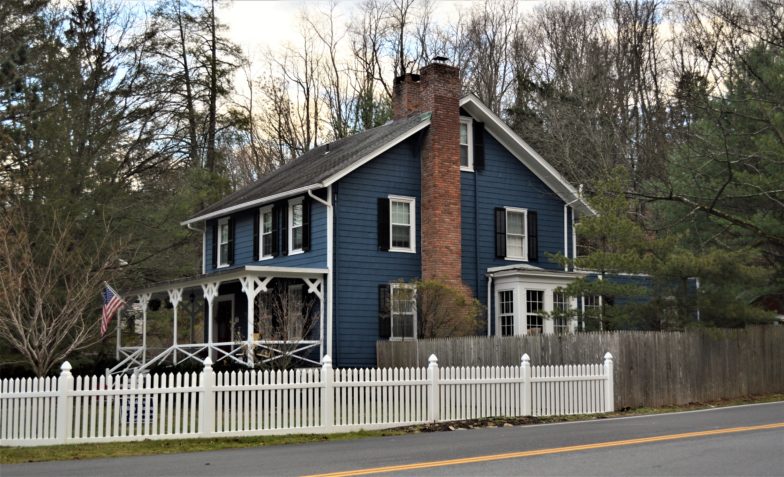
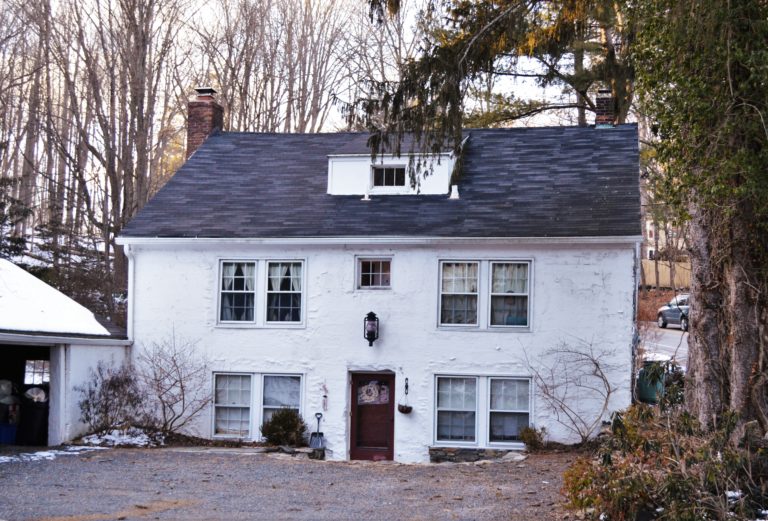





Quinby Family Plot
The Quinby family in New Castle goes back to the 1700s. We have already visited one of its branches, on Millwood Road. Another descended from Abraham Quinby. In the 1840s he acquired property straddling King Street east of Bedford Road. The bulk of it was inherited by his son Abram J. Quinby. He lived at the corner of King and Bedford, where the firehouse is now. His main business was a sheet-metal and plumbing supply firm, located across King Street on the site of the present Mobil Station.
Abram J. was a colorful and outspoken character. He was active in a lot of town affairs, and he took a particular interest in the nearby common school. He was a long-time trustee, and his prominent jug ears make him easily recognizable in school pictures.
In the 1890s, as the village of Chappaqua was steadily expanding, Abram J. began selling pieces of property along King Street for residential homes. In the following decade, he and his builder son, J. Sidney Quinby, drained an empty swamp east of King Street, and established there one of the first suburban subdivisions. They gave it the rather pretentious name De Quarmby Park. The roads though it were Ridgewood Terrace, Elm, and Maple Streets.
J. Sidney built his own house near the corner of Maple and King Street, an elegant home in the Colonial Revival style.
J. Sidney Quinby was probably responsible for erecting the family monument. His parents – “Father” and “Mother” — were buried there, and he himself and his wife would be buried there as well.

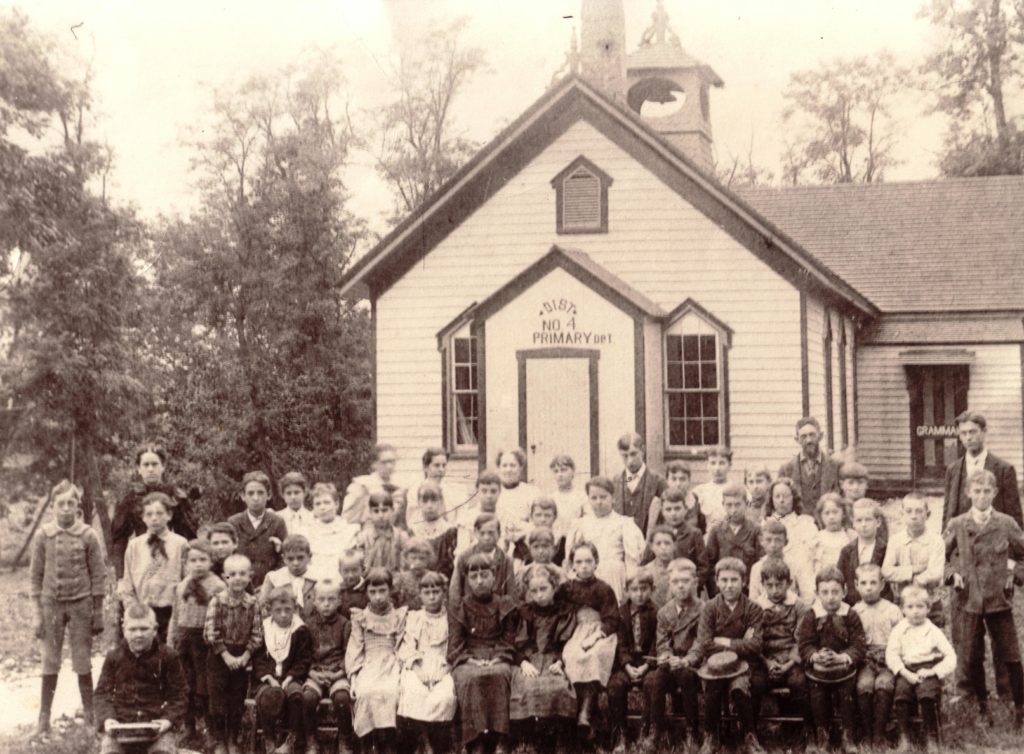





Washburn Sisters Gravestones
Recent generations of the Washburn clan included the Washburn sisters of Pleasant Valley Farm. There were five of them in all, but only one of them ever married. The other four are buried in this row.
Pleasant Valley Farm was a Washburn homestead from the 1820s. It is located on Briarcliff Road, just over the border from New Castle. But the Washburn sisters were always so active here — in the Chappaqua Quaker Meeting, the historical society, and so forth — that we have always considered them part of our community.
Quaker families were always, shall we say, close-knit. Cousins married cousins without hesitation. A recent genealogical study revealed that the Washburn sisters were related to the rest of the family in four different ways.


Gedney Family Plot
The Gedney family in Westchester goes back to Eleazor Gedney, who died died in 1722 at Mamaroneck. His descendant Bartholomew Gedney was a doctor, who moved to this area in the mid-1800s. His descendant Eugene Keteltas Gedney was the head of public works in New Castle for many years. He originally lived near the end of Seven Bridges Road, but he had to move when that part of the road was drowned under the raised Croton Reservoir in the early 1900s. He and his family then lived for two generations in a venerable old house on Quaker Road, near the intersection with Millwood Road.
His son Eugene V. Gedney was an extremely active citizen of New Castle. He held several town offices, and was involved in a wide range of non-profit organizations, from the Boy Scouts and Girl Scouts to the Chappaqua schools. His day job was as an executive of Kensico Cemetery, so he is buried there. Gedney Park on Millwood Road was named in his honor.


Patch Family Plot
The Greeley House in Chappaqua was the home of the Greeley family for only about a decade. But it remained in the possession of the family for many years afterward, and was rented out to a succession of tenants. In the early 1900s, it was occupied by Dr. Henry Francis Patch, who was a much-esteemed local physician. He may have chosen the house for its central location. He used it as both his home and his office. In a photograph, he appears on the front porch, with his disabled wife and other members of the family, including the family dog.

Ackerly Family Plot
You will now return to where you started. On the way, there is one more family plot to visit. William J. Ackerly was the Western Union superintendent at Grand Central Station in New York. He was also an active Democrat, who held several patronage appointments over his lifetime. In 1887, he bought the first plot on newly created Highland Avenue, off King Street. There he built a house in the ornate Queen Anne style then in fashion, with a commanding view of the village below. It has changed very little over the years.
It turned out to be more house than Mr. Ackerly could afford. The mortgage on it was foreclosed in 1893, and the Ackerlys moved permanently to White Plains. He may have bought this plot while still living here, for as you can see, he and several descendants are buried in it.







